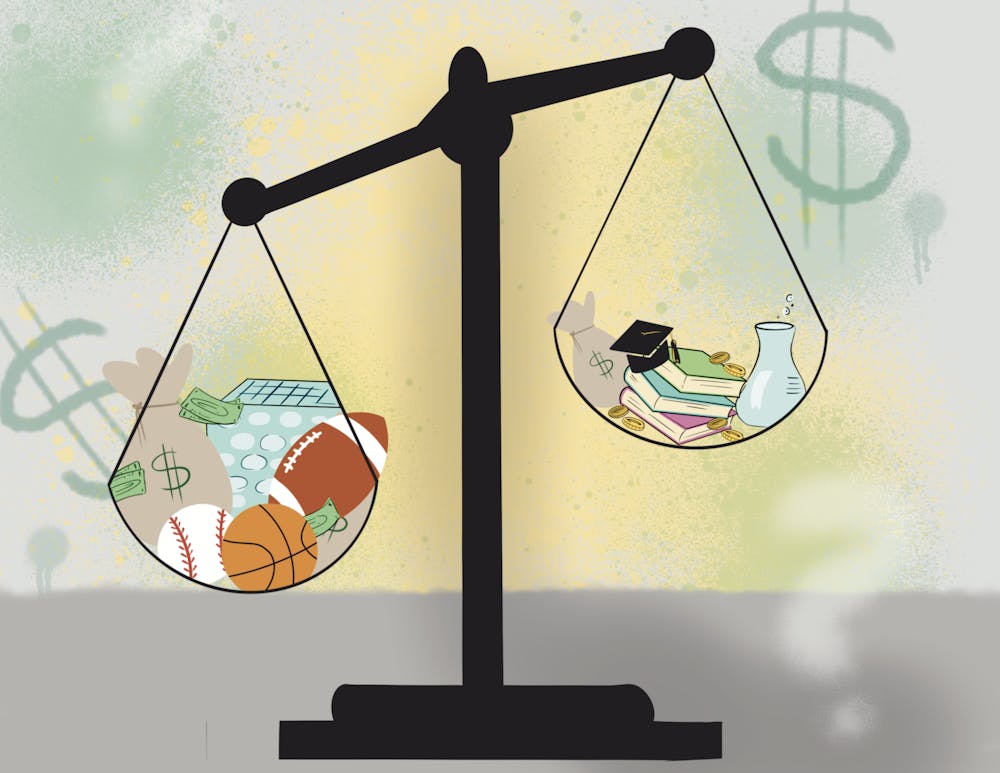UF has witnessed a trend of athletic budgets increasing at a comparatively faster rate than the budgets allocated toward its colleges.
The University Athletic Association, the department in charge of collegiate sports at UF, requested a $19 million budget increase for the 2022-23 school year.
Some UF students voiced concerns over the difference in athletic spending in comparison to education at the university.
Gabriel Vazquez, a 20-year-old UF English junior who transferred from Emerson University during his sophomore year, wishes the university would dedicate more resources toward the arts, he said.
“When I was at Emerson there was like 100 literary magazines there,” he said. “Here, there aren’t many well-known ones.”
Christian Wilder, a 20-year-old UF entomology and nematology junior, understands the importance of sports spending at the university and feels neutral about the amount it spends, he said.
“I get it,” Wilder said. “There is more funding toward sports because it brings more money into the university.”
However, he does wish the school would prioritize the arts, he said.
The UAA is a nonprofit organization and legally separate from UF, but it operates in accordance with the university. This means the budget expenses — which totaled $174 million during the 2022-23 school year — is also separate from the university.
Jamie Beach, a 20-year-old UF entomology and nematology junior, believes the spending process is acceptable, she said.
“If they’re taking money out of every student, like they’re taking a certain amount out of your tuition and then they skew things, that would be unfair,” Beach said. “But if they’re doing the funding on their own, that doesn’t make it unfair.”
Funds used toward education at UF aren’t taken away when UAA budgets increase. The association’s board of directors and athletic director Scott Stricklin have made contributions to the university and dedicated 10% of the UAA’s operating budget to UF support.
Beach hasn’t experienced any issues with funding as a student in the College of Agricultural and Life Sciences, she said.
“We’re one of the most well-funded schools and my major is also really well-funded,” Beach said. “So anytime I apply for scholarships, I basically always get it.”
The UAA experienced steady growth in its operating expenses and revenues prior to the 2021 fiscal year, which was impacted by the COVID-19 pandemic.
UAA operating expenses were expected to increase by $17.4 million in the fiscal year due to a nearly $8 million increase in salaries and fringe benefits as well as significant increases in scholarships and administrative services.
The increase in operating expenses reflects “an increased investment in our student athletes, coaches and support staffs,” the UAA 2022-23 Budget Summary stated.
The most costly expenses incurred from the usage of charter flights to nearly all Southeastern Conference away contests, a new dining facility and a $2.7 million increase in athletic staff salaries.
Notable expenses also came from improvements to Donald R. Dizney stadium, where the Gators lacrosse and soccer teams play, and the $85 million Heavener Football Training Center, which opened in August 2022.
However, many of these expenses were only made possible due to the $63 million of additional revenue the UAA has built over the last 10 years.
Despite the UAA being a non-profit organization, it has still achieved an extra $28 million from SEC Network and conference distributions, $10 million from ticket sales, $9 million from media rights and $5 million from booster contributions.
Gator Boosters, a fundraising arm of the association, has been a substantial revenue source for the UAA and contributed $38.4 million toward the annual budget.
Gary Condron, a Gator alum and the CEO of The Conlan Company, has donated more than $22.5 million toward projects at the university. Long-time Gators fan Hugh Hathcock, who is the CEO of Velocity Motors, made the single largest donation toward Gator Boosters in 2022 and gave the organization $12.6 million.
Florida requested a $164 million budget for the 2022-23 school year and made $190 million, according to a report by USAToday.
The revenue produced by the UAA and Gators athletics during the 2022-23 school year is the most among public universities in the state. Florida State University trailed UF and made $161 million during the timeframe.
Florida athletics revenue was the eighth highest in the nation and trailed four other SEC schools. Alabama, Georgia, Louisiana State and Texas A&M led the conference and Ohio State University led college athletics and produced $251 million in total revenue.
There isn’t a set date for when the 2023-24 budget summary will be released by the UAA. The association released its last two annual budget summaries in September.
Contact Luke Adragna at ladragna@alligator.org. Follow him on Twitter @lukeadrag.

Luke is The Alligator's Sports Editor and is a senior sports journalism student. In his free time, he enjoys playing with his cat named Pete and going down a rabbit hole of niche professional athletes (shoutout Charles Sims).






